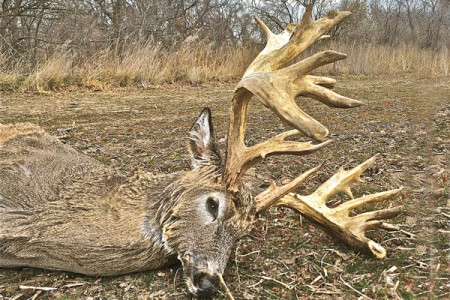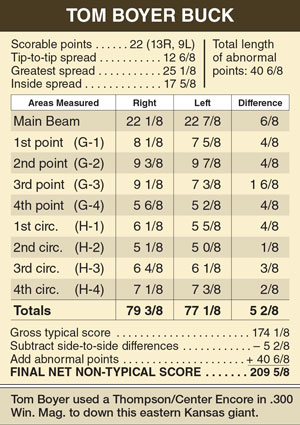![tom_boyer_buck_4]() Ever since the 1999 hunt on which I shot a 202 7/8-inch non-typical buck, Kansas has been my heart’s desire for hunting giant whitetails. That Neosho County trophy changed my life, helping me start down a career path that eventually led to my owning and operating Boss Buck Inc.
Ever since the 1999 hunt on which I shot a 202 7/8-inch non-typical buck, Kansas has been my heart’s desire for hunting giant whitetails. That Neosho County trophy changed my life, helping me start down a career path that eventually led to my owning and operating Boss Buck Inc.
So when in early 2013 Bob McConnell of Horseshoe Hill Outfitters approached me about hunting his Kansas ground, I was all ears. Horseshoe Hill has built a reputation for choice hunting properties. I’d worked with Bob for several years, having sent feeders and blinds to his eastern Kansas lease. And after seeing the results they’d produced, I was excited about hunting there.
![tom_boyer_ks2]() As we trophy hunters mature, we gain a greater appreciation for one fact: To shoot giants, you must hunt where they live. The Midwest farm belt is my first choice when chasing great whitetails. The percentages there are higher, I feel, than in any other region. So I was eager to try Bob’s ground.
As we trophy hunters mature, we gain a greater appreciation for one fact: To shoot giants, you must hunt where they live. The Midwest farm belt is my first choice when chasing great whitetails. The percentages there are higher, I feel, than in any other region. So I was eager to try Bob’s ground.
Four buddies and I entered the Kansas permit drawing, and we all were successful in the firearms draw for Unit 11. Having shot my best buck in that unit, I was excited to see the calendar make its way to Dec. 1. We made the 8-hour drive from Texas up to Anderson County, hoping for a chance at one of the big bucks spotted earlier in the fall.
Upon our 4 p.m. arrival in camp, Bob and one of his guides gathered our group in two trucks. We drove to each hunting location to get a visual of our entry paths for our predawn walk in. The temperature was dropping, and a thick blanket of fog began to form. We had just enough time to spot our next morning’s destinations from the road before dark.
That dense fog would greet me again the next morning for the half-mile hike to my Boss Buck tower blind. The outfitter had placed it in a thicket wedged between fields of cut corn and cut beans. An adjacent waterway winding its way through the bean field fed a small creek branch running through the farm.
It was so foggy I couldn’t see more than 100 feet until 9:30. Watching cottontails dart in and out of the brush just under my blind kept me entertained until the fog lifted and my setup between the fields was revealed.
The wind was blowing 25-35 miles per hour from the north, as a harsh cold front was making its way through the Midwest. And I suspect that’s why for 11 hours I saw no deer. The fact it was opening day of firearms season in Kansas helped keep me focused and on point, though. You just never know when another hunter or farmer might bump the buck of a lifetime from a nearby plum thicket or field.
About 4 p.m. I was startled when my blind began to shake. The strong wind that had caused it to vibrate on and off since daylight hadn’t been this pronounced. Turning my head to the window facing the 10-foot staircase, I saw Bob climbing up.
Seeing the obvious look of excitement on my outfitter’s face, I wondered if he was about to deliver good news or bad. His first words were, “Get your gun and come with me now. There’s a big boy in the house.”
Our other guide, Albert, had spotted a giant buck crossing a nearby road at about 2 p.m., as Albert made his way back to camp after dropping off hunters who’d returned for lunch. When he got back to the camp, he told Bob about the big deer and the doe he was following. It was impossible to know whether other hunters had bumped the pair or if perhaps the excavator removing trees on a neighboring farm had caused them to move.
Regardless, after hearing Albert’s report, Bob headed back over to the farm I was hunting and began glassing the woods line and field edges. Finally, at about 3:30, he spotted the giant buck bedded along the creek in some high prairie grass on the edge of the cut bean field. As soon as Bob saw the doe and giant buck he distanced himself from their line of sight and started the half-mile hike to my blind. From the look on his face, he’d made the trek much faster than I had 11 hours earlier in the dense fog.
Hearing this report, I was instantly warmed by adrenaline coursing through my body. I knew Bob’s standards on trophy bucks to be high; when he says it’s a big deer, you can bet it’s big. So in short order we were making our way across the cut bean field and across the waterway, which was now frozen solid. With each quick stride I could tell Bob was pumped at the thought of my getting an opportunity at this buck.
At the pickup, I quickly removed the underlayers of my Scent-Lok suit to facilitate the stalk. It was now about 4 p.m., and any chance at this buck on opening day was going to come quickly . . . or not at all.
Bob drove us to the spot best suited for us to launch our approach, and the timing couldn’t have been better. One of the many trains passing the farm that day was going by right next to where we had to start our pursuit of the giant buck. The noise from the passing train covered our sounds and allowed us to cover the first 100 yards in a half-bent-over trot.
As soon as the train moved on, we gained an appreciation for the gusty north wind that had been hindering our hunt all day. It was now our best friend! Bob had wisely placed us south of the two deer’s position. He signaled to drop to all fours, and we crawled another 60 yards. Trying to keep the Thompson/Center Encore slung across my back was becoming a chore at the pace we were moving to beat the end of shooting light.
We crept to a sparse old fencerow that ran east-west between the train tracks and the cut beans. There was one shrubby tree in the fencerow, and we made that our goal for my being able to get my first look at the buck. Once we reached that point, Bob slowly rose to his knees and raised his binoculars for a quick peek at the spot where he’d last seen the deer bedded. Meanwhile, I was lying on the cold ground, watching Bob’s every expression for some sign the pair hadn’t relocated.
![tom_boyer_buck_2]() My adrenaline spiked when I saw the look on the outfitter’s face. Dropping much faster than he’d risen, Bob implored me to slowly ease to the small shrub and glass the prairie grass adjacent to the beans. His contagious excitement had me eager to see the brute that had him so wired up.
My adrenaline spiked when I saw the look on the outfitter’s face. Dropping much faster than he’d risen, Bob implored me to slowly ease to the small shrub and glass the prairie grass adjacent to the beans. His contagious excitement had me eager to see the brute that had him so wired up.
From behind the bush, I glassed the edge of the field in the direction Bob had pointed to. Sure enough, nestled in the swaying Kansas prairie grass was a huge rack: one of such magnitude my brain couldn’t accept what my eyes were telling it. Never before had I believed a moment like this would ever be mine.
The adrenaline pumping through my veins now had to be controlled. My breathing pattern was no longer heavy from the all-fours crawl but from the excitement of this once-in-a-lifetime opportunity.
Daylight was fading, and yet all I could see was the massive rack sticking up in the swaying grass. My binoculars revealed there was simply no good shot. When I broke the news to Bob, he established a new goal: the last sprigs of sparse prairie grass that lined the old fencerow, a distance of about 40 yards ahead. To reach it without being busted, we’d have no more cover than an old fence post and a thin stand of the blond, swaying grass between the deer and us. At Bob’s first move, I followed flat on my stomach with my rifle across my back, praying with every frog-style motion we made inching across the frozen ground.
Upon reaching our destination, I noticed the old fence post had some remnant wire hanging off both sides and running loosely back to the tree we’d just left. It definitely wouldn’t be of much help as a rifle rest.
The grass was so short I didn’t dare get onto my knees to find the deer in my scope. Lying on my side, I finally located the buck with my binos again. I now felt better about how his body was positioned behind the grass he and the doe were bedded in. Looking over at Bob, I confirmed we now had an acceptable angle, and he gave me the thumbs up to take the shot if I felt I could make it.
Checking the distance with my Nikon rangefinder, I saw it was 179 yards. But when I raised my Encore, Bob’s eyes widened. “Oh, no,” he frantically whispered. “You brought a muzzleloader?”
I assured Bob it was in reality a .300 Win. Mag., but even that failed to put him totally at ease. “It’s a single shot! You got any more bullets?”
I confirmed I did, prompting Bob to ask if he could hold a round, in the event a follow-up shot was needed. I obliged him with a 180-grain Hornady cartridge from my pocket.
Knowing I couldn’t even come to my knees without breaking the little concealment we had, I decided to lie on my left side, using my left elbow for as solid a rest as could be achieved within the slight incline of the old fencerow. But when I shouldered the rifle, the sight of the crosshairs oriented at a 10-4 o’clock angle was definitely a different look from the normal 12-6 position we all practice from. Even so, I didn’t figure that would matter if I aimed at the right spot and squeezed off a clean shot.
I settled the crosshairs where I needed to place the bullet and steadied the rifle. Whispering “fire in the hole” while floating the crosshairs on the spot, I gently squeezed the trigger until the recoil removed the buck from my view.
![tom_boyer_buck_3]() Refocusing the scope on the buck’s massive rack, I saw his head bobble as if he were struggling to stand up. Quickly I broke over the Encore, pulled the empty casing from its bore, threw it aside, loaded Bob’s extra and brought the rifle back to my eye.
Refocusing the scope on the buck’s massive rack, I saw his head bobble as if he were struggling to stand up. Quickly I broke over the Encore, pulled the empty casing from its bore, threw it aside, loaded Bob’s extra and brought the rifle back to my eye.
As soon as I got the buck’s rack back in the scope, he disappeared behind the grass. Instantly I looked at Bob for his reaction. He asked how I felt about the shot. I responded that it was a good one. You know that feeling the instant you release an arrow or a bullet. You know instinctively from practicing if your shot was on the money or not.
Bob said the buck had tried to stand but then had gone down into the creek just behind where he’d been bedded. So we eased our way back to the truck for a 30-minute wait before taking up the trail.
Upon reaching the deer’s bed, we found only a little hair. His slide down the dirt bank into the shallow creek also indicated a hit, but there was no blood there, either. At this point it was after 5 p.m. and rapidly getting dark, so we decided the only smart play was to back out and wait till daylight to look for the buck.
As you can imagine, that was the longest night of my life. I could only relive the moments surrounding the shot and second-guess my every move. Had I put a solid hit on this monarch, or had I only wounded him, due to the stiff wind and my awkward shooting position?
My good friend Dan Ross, with whom I practice shooting rifles and bows, assured me that if I felt the shot was good, the equipment had done its job. Dan and I use this same rifle-ammo combination for hunting Canadian whitetails, which on average have the largest bodies of any in the world. Surely that Hornady bullet had done its job and had cut the prairie grass the giant buck had been bedded in.
At 9 a.m. we left the lodge to begin looking again. Not knowing if the buck might still be mobile, I resumed my position in the tower blind. Once I reached it, Bob, Dan and Albert started into the woods where the buck had vanished. I now could tell the giant and his doe had been bedded under 400 yards from where I’d sat 11 hours the day before.
Anxiously I watched the brush to make sure the buck didn’t get past me. I was looking everywhere and listening to every sound. Before long, from the far end of the field I saw a group of turkeys flush ahead of our team. Next came two of the trackers themselves. Toward me down the cut-corn edge they walked, scouring the ground for signs of the hit.
Suddenly Bob raised his right thumb and then pointed at the ground, signaling he’d found blood. Shortly afterwards, the team disappeared into the dark, thick brush that edged the creek. Bob came back out and signaled me to come to his position. I was now euphoric at the anticipation that the buck was indeed dead and I was about to get my first real look at him. My trek down the stairs of the blind was more like a squirrel scrambling in a forest fire! I now knew I’d topped my previous best whitetail by a wide margin.
As I approached Bob, I could see the blood he was pointing out. The emotions of the night before began to release from my mind and body; tears began to fill my eyes from the relief and euphoria of the moment.
Knowing this dream was about to become a reality was overwhelmingly gratifying. No more doubt, and no more fear of failure. In just moments I’d be holding the huge rack I’d seen in the grass the day before and in my head all night.
As we approached the creek through the thicket, I could see the looks on Dan and Albert’s faces. Bob became excited as well as we made our way to the creek bank where we could see the buck lying in the frozen creek. I immediately jumped into the creek and broke through the ice that had entombed the buck during the night.
The deer almost looked fake to me as I grabbed his massive non-typical rack. The frame was huge, and the number of points was seemingly endless. The long, split brow tines and sticker points all over his massive headgear were amazing.
Dan actually had found the buck, and that seemed appropriate. His reassurance the night before and his sacrifice of his own morning hunt to help recover my buck are a testament to his character.
You could tell the bullet had done its job. It had entered the buck’s left shoulder and had caused the precise damage for which it was designed. The giant buck had rolled down into the creek from where he’d been shot, then came out of the thicket at the edge of the corn field and made a 20 yard U-turn back into the thicket, dying in the creek he’d crossed moments before. Bob said he figured the buck was lying in the creek when we initially tried to recover him, but we hadn’t wanted to push our luck.
![tom_boyer_chart2]() After I’d filled out my tag and we’d double-checked my documents, we took a few photos of the deer and the location, trying to record and preserve this moment in time as best we could. Once we arrived back at the lodge, we took more photos. I even had the privilege of taking one for the local game warden that checked the buck. He’d seen mine and another giant that had a typical 12-point frame in that same area of Unit 11. The warden estimated that other buck also would exceed 200 inches.
After I’d filled out my tag and we’d double-checked my documents, we took a few photos of the deer and the location, trying to record and preserve this moment in time as best we could. Once we arrived back at the lodge, we took more photos. I even had the privilege of taking one for the local game warden that checked the buck. He’d seen mine and another giant that had a typical 12-point frame in that same area of Unit 11. The warden estimated that other buck also would exceed 200 inches.
Later, my good friend Austin Grubbs with Boss Game Systems pulled out his measuring kit. Growing up on a South Texas ranch gave him the bug for scoring big whitetails. Albert, who’d first seen the big buck cross the road, also scored the giant. After both guys had taken their turns, we were confident my deer would net well in excess of 200.
The culmination of a 33-year hunting career was truly a humbling experience. Odds are I’ll never lay eyes on another free-range whitetail of such magnitude. Then again, someone told me the same thing after I killed that big one in Kansas back in 1999. All I know is that I’ll keep chasing big whitetails as long as God gives me the blessing of being able to.
×
A.J. Downs
Over his years of chasing whitetails, A.J. Downs of Conroe, Texas, has taken a number of big bucks with his bow. But none of the other mounts in his trophy room can match the size, or the meaning, of the freak whitetail that fell to his arrow shortly after daylight on opening day of the 2012 archery season.
To read more about this freak whitetail, check out
NAW's Deer of the Day entry.
Bill Ulrich
Thirty-five years of bowhunting have taught Bill Ullrich a few things about chasing whitetails.
On October 26, 2012, Bill had made up his mind to take off work early to spend an afternoon in the woods, and he knew exactly which tree he was headed for that afternoon. He was almost to the tree when something told him he needed to turn around and, instead, opt for a tried and true setup he had long-ago named the “good luck tree.”
One hour and ten minutes later, he realized that was the best decision he had ever made, as he watched his arrow bury to the nock in the largest whitetail buck he had ever shot at.
To read more of Bill's story, check out
NAW's Deer of the Day entry.
Bill Winke
Bill Winke has earned himself a spot as one of the best Midwestern whitetail hunters of all time, with a recent buck to prove it. To read more about this massive double G4 Iowa giant, check out
NAW's Deer of the Day entry.
Bo Russell
The huge Iowa non-typical Bo Russell arrowed in the 2012 season is a testimony to the rewards of smart scouting and hard work. Not to mention being adaptable enough to overcome some outside interference—including a crew of archeologists!
Russell's giant had a gross score of 246 4/8 inches and a net of 231 4/8. That made him the second-largest bow kill entered from that season.
To read more about Bo Russell's giant, check out
NAW's Deer of the Day entry.
Brian Herron
Brian Herron fought numerous obstacles and setbacks in 2012 to bag this 184-inch bruiser. Read the full story in
NAW's Deer of the Day entry.
Brian Hollands
After many years of chasing the same buck and coming up empty, Brian Hollands' luck finally turned around. On a fateful morning in 2012, Hollands not only found a lost little girl wandering the back roads of Missouri, he also found the buck of a lifetime. Check out the full story at
NAW's Deer of the Day.
Dale Gertz
Dale Gertz set a new Maryland record with this 208-inch non-typical monster. Read the full story in
NAW's Deer of the Day entry.
Dan Daigle
The 16-point Daigle buck, scored by Boone & Crockett measurer Lonnie Desmarias, grossed a whopping 197 0/8 inches gross and netted 191 0/8 inches as a non-typical, breaking the existing Massachusetts state record by seven inches, according to the Northeast Big Buck Club records.
To read more about Daigle's Booner buck, check out
NAW's Deer of the Day entry.
Dean Partridge
In 2009, Dean Partridge started having encounters and getting trail camera photos of a small 4×4 whose back tines were a little bladed. There was nothing out of the ordinary at the time, so Partridge and crew carried on filming that fall and finished off the season. The next summer, he was back in the woods, checking to see which bucks had made it through the harsh winter. And much to his surprise, the buck that seemed ordinary had grown into an extraordinary buck with a large droptine that he aptly named Droppy.
In the early spring of 2012, Partridge started looking for Droppy again. This time, he found him in May, in the same patch of timber he had frequented in the past. His typical frame was huge, and he carried big, split brows and matching flyers on both sides but his droptine was gone. We decided that this deer would consume my season until we were able to get an encounter with him.
To read more about Dean's Canadian giant, check out
NAW's Deer of the Day entry.
Dylan Beach-Bittner
Have you seen the (almost) Turdy-Point Buck?
Taking a cue from the popular folk rap song, 12-year-old Dylan Beach-Bittner, downed a 27-point Minnesota monster scoring 241 green.
For more info, check out Beach-Bittner's Deer of the Day entry.
Fred Swihart
You need only skim the pages of the record books to understand why the majority of hunters pick the November rut as the prime time to hunt giant whitetails. Mature bucks are never a pushover, but they are more vulnerable when their nose is glued to the ground trailing an estrus doe. Fred Swihart proved, however, that you can have success outside the rut—sometimes it's just a matter of persistence. Check out the full story at
NAW's Deer of the Day.
Garry Greenwalt
Garry Greenwalt teamed up with North American Whitetail's Gordon Whittington to kill this amazing Washington buck, known to Greenwalt as "The Ghost." Greenwalt spent a good deal of time tracking down the amazing 172-inch Washington giant, but it was all worth it. Read the full story at
NAW's Deer of the Day.
Garry Morris
It was mid-afternoon on Nov. 13, 2009, and Gary Morris of Winslow, Ark., was heading south out of Iowa. Driven by a haze of internal frustration, he was headed back to Arkansas six days early. The last three years of planning, anticipation and excitement for his Midwestern hunt had been stolen by an encounter with a 170-inch behemoth buck and a blown 12-yard “chip-shot.” After his miss, Morris thought about giving up bowhunting altogether. But it's a good thing he didn't. Read about his unlikely comeback—as well as his 221-inch monster—in
NAW's Deer of the Day.
Jason Tuttle
On Nov. 14, 2012, the wind was right for hunting, and Jason decided to sit all day. At about 7:30 a.m., he heard chasing over the steep hill in front of him. Then a doe came running up the hill and went past him. Jason could hear grunting from the cedars below. It was the buck he had named Cyclops.
With the buck at only 70 yards, Jason cranked up his scope and looked at the buck closely. Immediately he saw the glassy eye, and he knew Cyclops was his. It was a chip shot for his accurate .270 Win. After the shot, the huge buck only went about 75 yards before he crashed.
To read more about the Cyclops buck, check out
NAW's Deer of the Day entry.
Jay Price
Like any bowhunter who has chased mature whitetails, Jay Price is proof dedication and tenacity are often factors to success. On a fateful day in Kansas, Price once again went through his scent-masking ritual and headed to a treestand that was positioned in the hedgerow deeper into the property. It hadn't worked until that moment, but things were about to change. Get the full story at
NAW's Deer of the Day.
Jeff Iverson
Earlier this year, Jeff Iverson killed what might be the new non-typical record for a Minnesota whitetail. This is the third season that Iverson hunted this particular buck. Two years ago, when the buck was a six-by-six typical, he missed a shot at it with his bow.
For more, read the rest of the story in NAW's Deer of the Day entry.
Jeremy Schmeidler
After years of hunting other people’s property, Jeremy finally got his own in 2010, when he purchased a 750-acre property consisting of river bottom cover and cropland. He immediately planted multiple food plots, his favorite crop being milo.
Jeremy didn’t know of the buck’s existence before 2012. Although there is a chance the buck had always been on his property, Jeremy’s numerous trail cameras never revealed the buck’s presence during the previous 2011 season.
Nine straight days of hard, smart hunting paid off big for Jeremy, and sharing that success with a good friend made it even more special.
To read more about Jeremy's giant, check out
NAW's Deer of the Day entry.
Jim Cogar
Despite one of the worst droughts in history, in July 2012 Jim Cogar’s expectations for deer season in central Ohio were as high as ever. Trail cameras were set, mineral sites were established, and other attractants were strategically placed throughout the farm.
After discovering a giant on his trail camera, that he aptly dubbed Conan, Cogar set out on a mission to bag Conan before the end of the season.
It was Super Bowl Sunday before the opportunity presented itself to Cogar. As Conan led two young bucks down a hill, a distraction opened the door for Cogar to bag his buck of a lifetime.
To read more about Jim Cogar's Super Bowl buck, check out
NAW's Deer of the Day entry.
Jim Hill
For bowhunter Jim Hill, of Hebron, Ky., the 2011 season had been somewhat frustrating. Although he had seen numerous deer and taken several does, closing the deal on a mature buck had proved to be a difficult proposition.
“After what seemed like an eternity, the doe slowly turned and began to walk. I immediately drew the bow as the buck stepped forward to follow her. After waiting for just a moment until the deer entered the small opening where the doe had been standing, I softly mouth bleated to stop him, aimed and released.”
To read more about Jim's grapevine giant, check out
NAW's Deer of the Day entry.
Joshua Earp
Joshua Earp's Georgia giant scored 187 inches green, weighing in at 235 pounds, and was a great October surprise.
"“I’ve hunted 25 years for this," Earp said. " I give all thanks to God and my father for teaching me and introducing me to this sport I’m addicted to.”
For more, read the rest of the story in this Deer of the Day entry.
Lindsay Groom
With the help of her husband, Kevin, Ohio resident Lindsay Groom scouted this buck for two weeks before coming across its path again on Nov. 7. Lindsay shot the buck with her crossbow at about 10 yards, but was unable to locate the buck.
After watching the kill shot again on film, the couple decided to track it the next morning, finding the deer just 30 yards away from where they stopped looking the night before.
For more info, check out Groom's Deer of the Day entry.
Lucas Cochren
Lucas Cochren killed an amazing 238-inch Kansas trophy, but it all started with a blood trail gone cold. Fortunately, Cochren stuck to it and bagged the trophy of his lifetime. Check out the full story at
NAW's Deer of the Day.
Mike Giarraputo
Mike Giarraputo set a New York state record with this 210-inch non-typical bruiser. Read the full story in
NAW's Deer of the Day entry.
Mike Miller
It was October 7, 2012, and a cold front had pushed through the eastern Arkansas Delta, dropping the temperature into the mid-50s. The low country heat had hovered in the 70s and 80s for the previous weeks, and this was the break that Mike Miller, of Marion, Ark., was waiting for. Just 10 days prior, a familiar old buck had shown up on his trail camera, but, this year, the beast had sprung into an entirely new category of whitetail.
To read more of Mike Miller's captivating story, check out
NAW's Deer of the Day entry.
Mike Moran
Mike Moran's Saskatchewan buck was a dream come true for the hunter who'd spent 27 years looking for a deer of that quality. He finally got his wish on Thanksgiving day, an experience he won't forget. Read the full story in
NAW's Deer of the Day entry.
Paul Keller
Having chased whitetails in Wisconsin since 1978, Marion bowhunter Paul Keller is no stranger to monster bucks, but this year was decidedly different. Keller dropped a 229 2/8-inch buck that will challenge for the top of the record books when all is said and done.
For more, read the rest of the story in this Deer of the Day entry.
Payton Mireles
Payton Mireles, age 10, of Ind., killed her first buck in 2012, a 154-inch bruiser. Read the full story in
NAW's Deer of the Day entry.
Randy Walk
It's pretty safe to say Randy Walk, president of
Hoyt Archery, knows a thing or two about bowhunting.
Nevertheless, the 225-inch Kansas beast shared by Hoyt's Facebook page stands alone as the biggest buck he'd ever seen, he said.
“He is a giant buck. Eighteen points total with nine on each side. He has been green scored at 225 inches and some change and is clearly the largest whitetail deer I have ever seen on the hoof or on the ground for that matter."
For more info, check out Walk's Deer of the Day entry.
Rhett Butler
Having two years of history with this particular buck, Rhett Butler was able to track where he had taken pictures of Hercules. The deer seemed to be ranging over 1-1.5 square miles revolving around a 100-acre alfalfa field.
When the buck stepped out, Rhett put the crosshairs onto the buck’s left shoulder and squeezed the trigger of his Winchester .270 bolt action. At the crack of the rifle the buck dropped in his tracks and never even kicked. The hunt for Hercules was over.
To read more about the Butler's hunt for Hercules, check out
NAW's Deer of the Day entry.
Robert Taylor
Killing the buck that had come to be known to the Taylors as “Big Daddy” was Robert’s primary focus in the fall of 2012. He arranged his work schedule so he could be in a deer blind most mornings and afternoons during the waning weeks of the season.
Despite having nine sets of eyes within 15 yards of him, Robert somehow brought his trusty PSE to full draw without blowing his cover. He waited patiently for the shot he wanted, and when the buck turned broadside, Robert drilled him. The giant ran about 100 yards before he piled up.
To read more about Taylor's massive Texas giant, check out
NAW's Deer of the Day entry.
Ryan Dietsch
After a sleepless night and an unsuccessful afternoon tracking a blood trail, Ryan Dietsch was sure he'd squandered the opportunity of a lifetime. He and friends went back to track the deer he thought he'd hit, but couldn't find so much as a drop of blood. His luck all changed, however, and the rest—along with his 219-inch trophy—is history. Check out the full story at
NAW's Deer of the Day.
Shane Frost
Whitetail fate played its hand for Arkansas’ Shane Frost on January 23, 2012. The setting was in the big-timbered, fertile ground of the Black River Bottoms in Clay County in northeast Arkansas. The ancient oaks and sloughs, in all their years, had likely never witnessed a more epic bowhunting scene. So began Frost's whitetail season, which ended with a 216-inch trophy on his wall. Read more at
NAW's Deer of the Day.
Stanley Suda
Southern Ohio turned in another giant earlier this season when Stanley Suda shot this buck which is estimated between 235 and 240 inches.
"The shot was perfect," he said. "I watched my dream buck run across the field and pile-up about 20 yards inside the wood line. This was definitely my finest moment in the treestand.”
For more, read the rest of the story in this Deer of the Day entry.
Tim Beck
To read more about Tim Beck's No. 4 all-time B&C buck, check out
NAW's Deer of the Day entry.
 Over his years of chasing whitetails, A.J. Downs of Conroe, Texas, has taken a number of big bucks with his bow. But none of the other mounts in his trophy room can match the size, or the meaning, of the freak whitetail that fell to his arrow shortly after daylight on opening day of the 2012 archery season.
Over his years of chasing whitetails, A.J. Downs of Conroe, Texas, has taken a number of big bucks with his bow. But none of the other mounts in his trophy room can match the size, or the meaning, of the freak whitetail that fell to his arrow shortly after daylight on opening day of the 2012 archery season. running with a bachelor group of bucks, bouncing around between two stands we call ‘Big Lake 1’ and ‘Big Lake 2.’ He was coming to our corn feeders twice a day like clockwork.”
running with a bachelor group of bucks, bouncing around between two stands we call ‘Big Lake 1’ and ‘Big Lake 2.’ He was coming to our corn feeders twice a day like clockwork.” Amazingly, A.J. managed to remain as cool as a cucumber despite being within near watermelon seed-spitting distance of the largest free- ranging whitetail he’d ever seen. He was so calm, in fact, that he reached for his video camera before his bow.
Amazingly, A.J. managed to remain as cool as a cucumber despite being within near watermelon seed-spitting distance of the largest free- ranging whitetail he’d ever seen. He was so calm, in fact, that he reached for his video camera before his bow.![]()
![]()
![]()
![]()
![]()
![]()
![]()
![]()
![]()
![]()
![]()
![]()
![]()
![]()
![]()
![]()
![]()
![]()
![]()
![]()
![]()
![]()
![]()
![]()
![]()
![]()
![]()
![]()
![]()
![]()
![]()
![]()
![]()
![]()
![]()
![]()










































































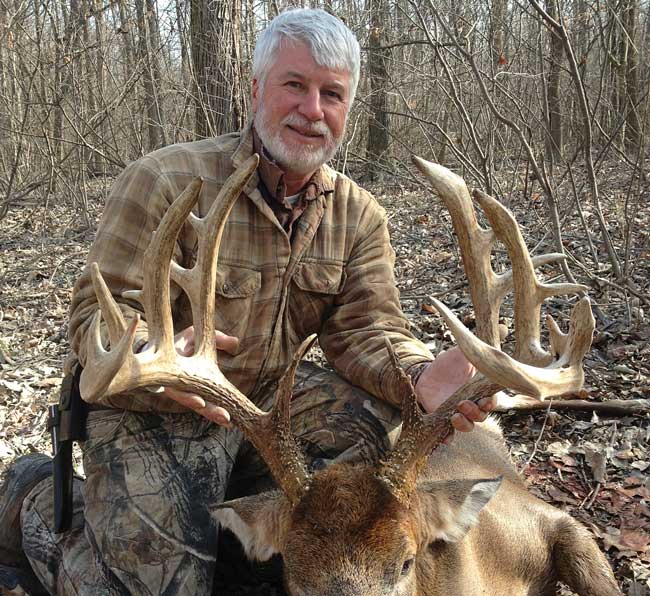

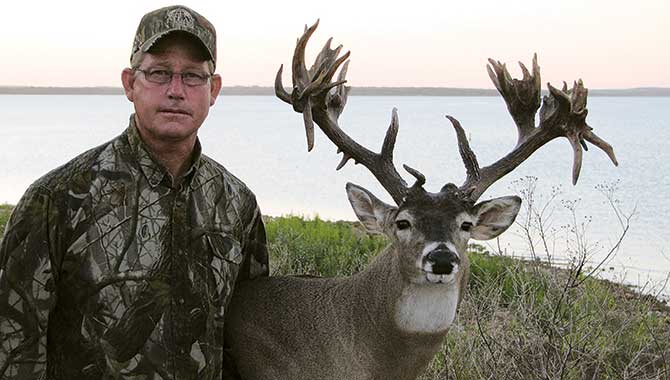
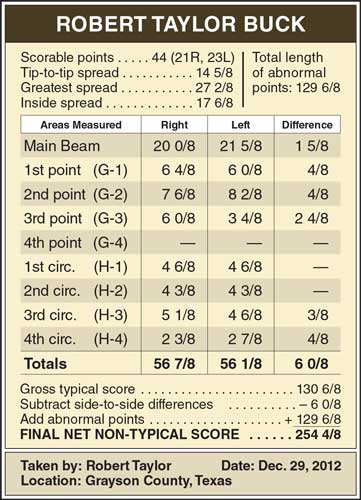


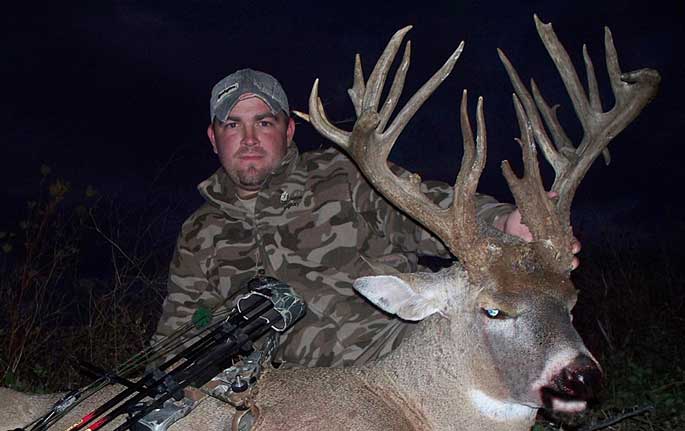

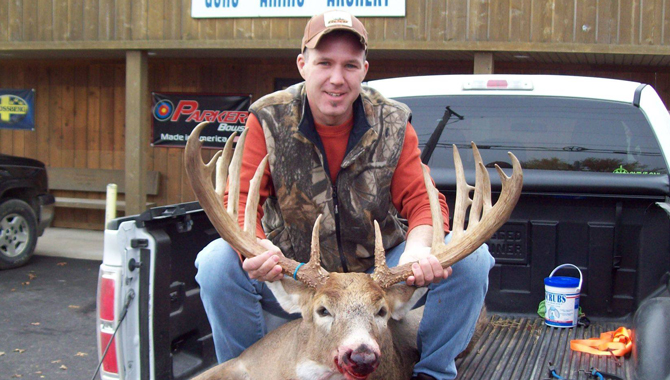










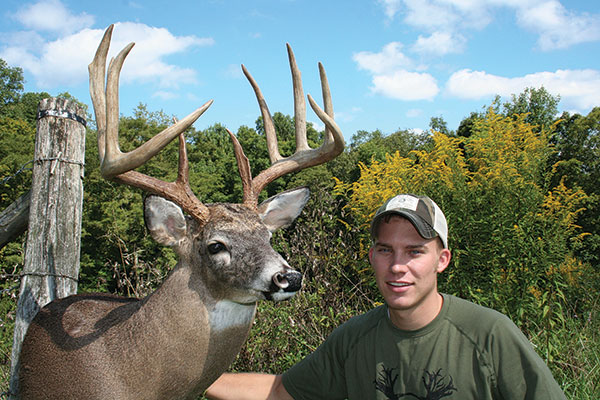
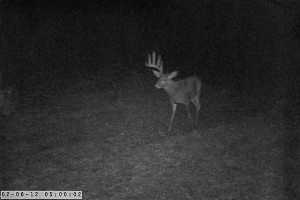
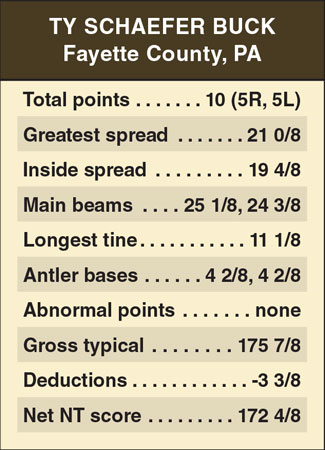

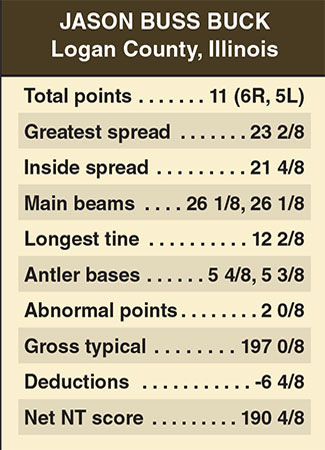
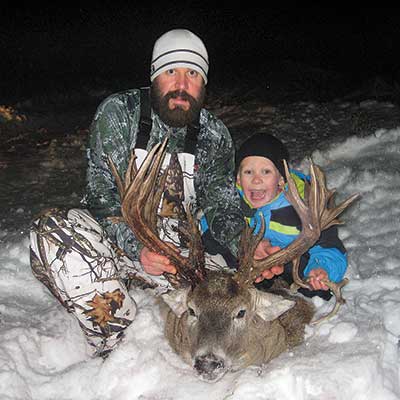

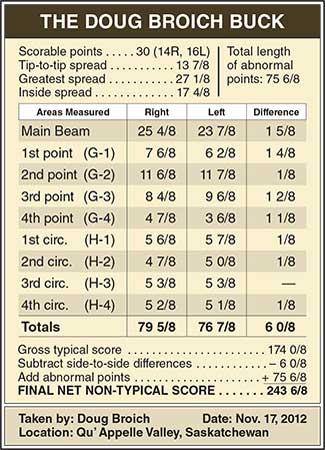


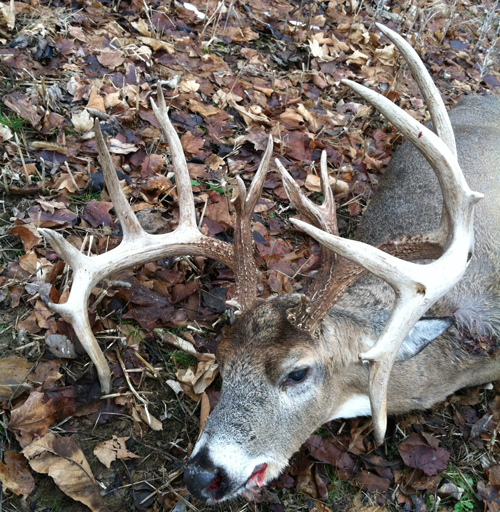
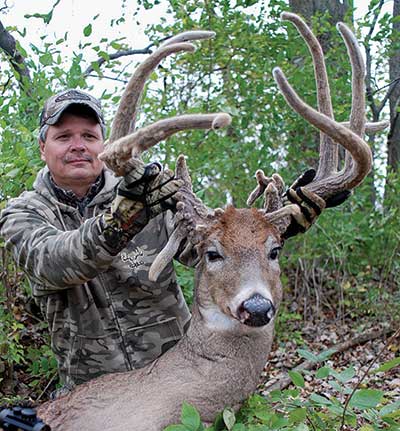
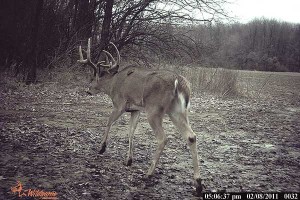


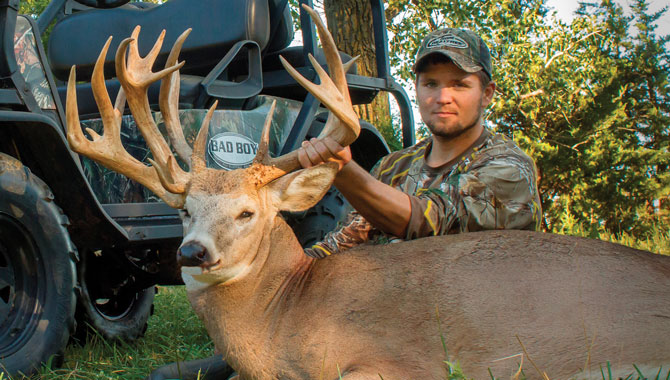

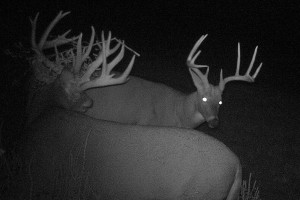
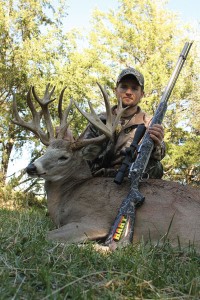
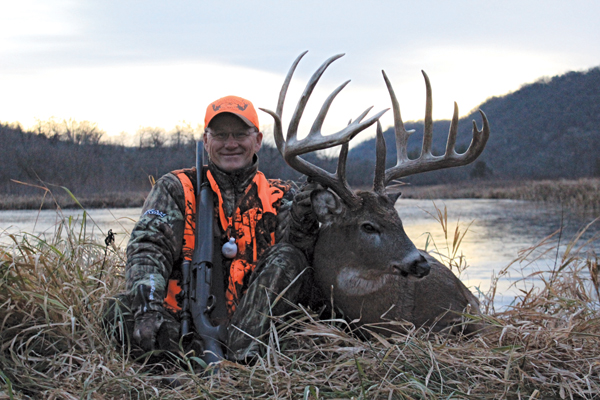
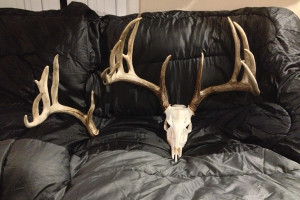
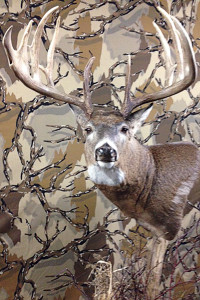
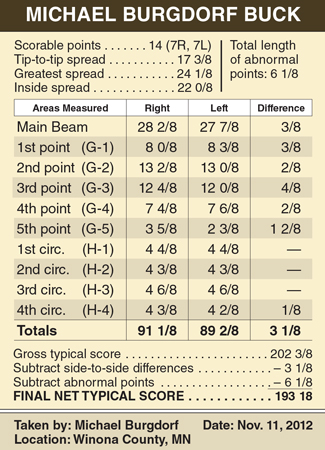



























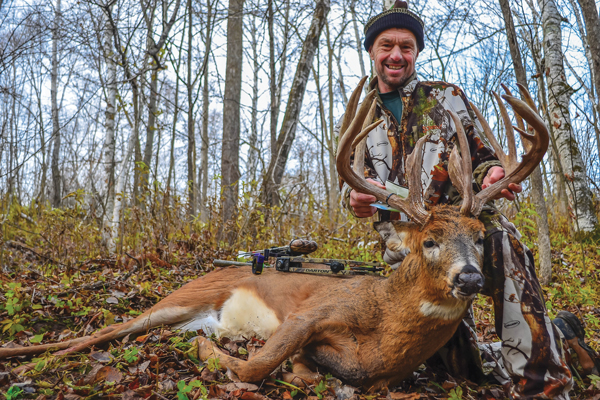
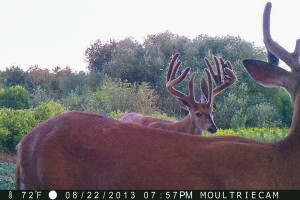
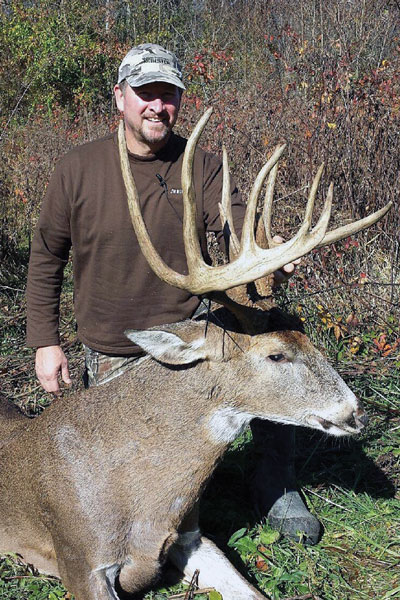
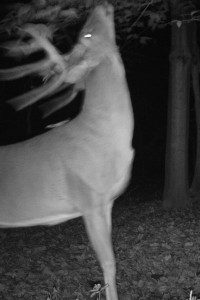
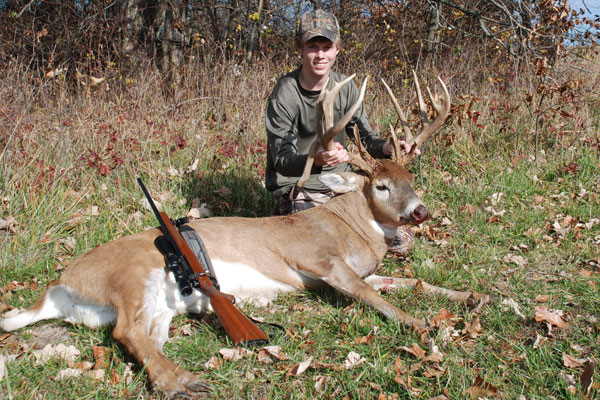
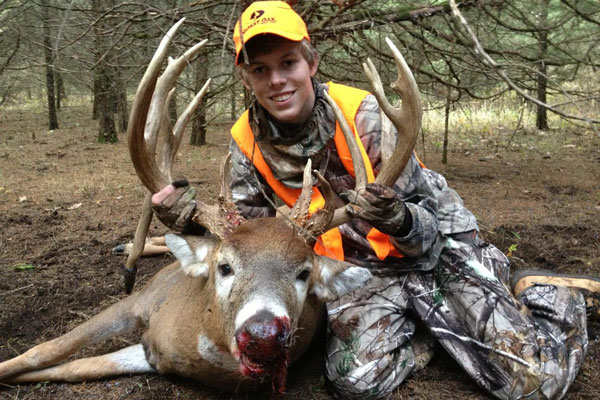
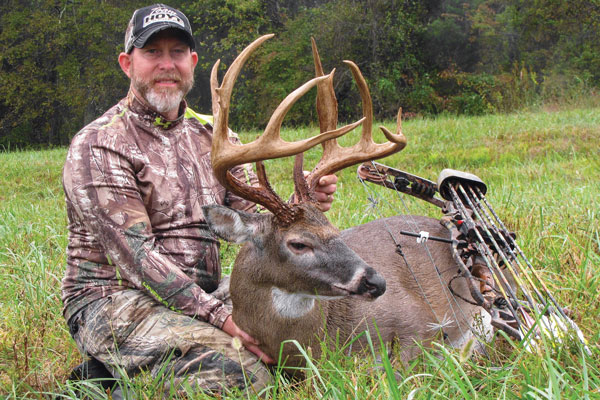
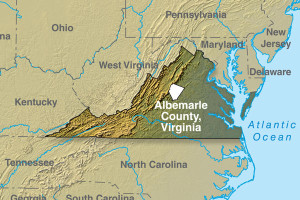
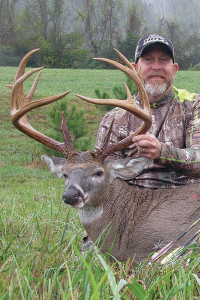
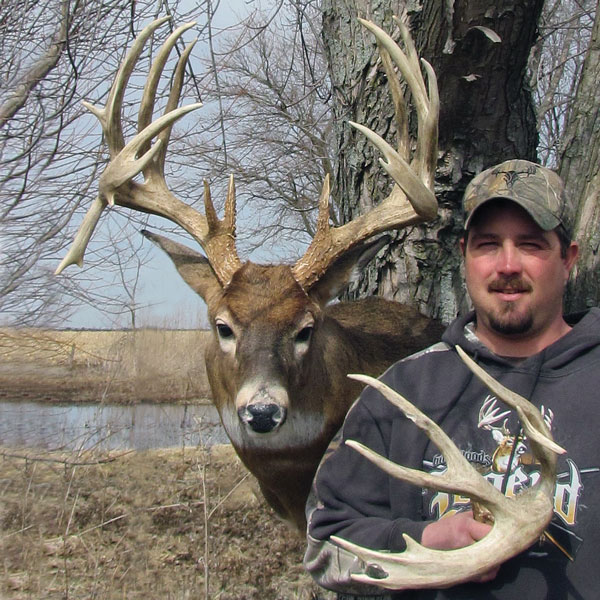


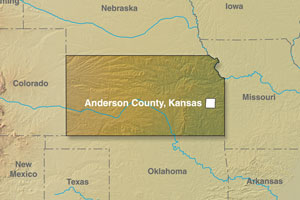
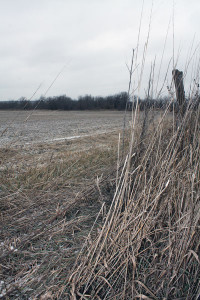 My adrenaline spiked when I saw the look on the outfitter’s face. Dropping much faster than he’d risen, Bob implored me to slowly ease to the small shrub and glass the prairie grass adjacent to the beans. His contagious excitement had me eager to see the brute that had him so wired up.
My adrenaline spiked when I saw the look on the outfitter’s face. Dropping much faster than he’d risen, Bob implored me to slowly ease to the small shrub and glass the prairie grass adjacent to the beans. His contagious excitement had me eager to see the brute that had him so wired up.